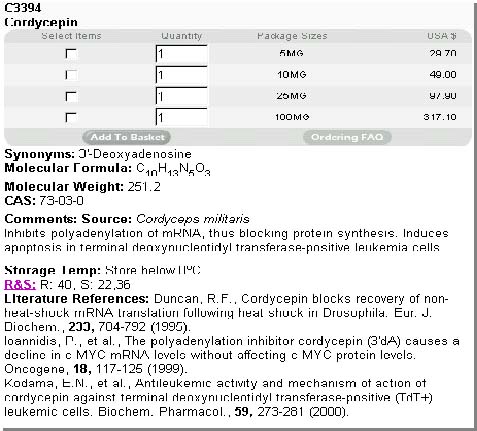![]()
3'deoxyadenosine (cordycepin) was one of the first naturally occurring nucleoside antibiotics isolated. It was originally described as an analog of adenosine in which the ribose moiety was replaced by a branched carbon-chain 3?/span>deoxypentose.
In relation to human health, much current concern has been focused on naturally occurring bifidus factors and growth inhibitors against harmful bacteria such as Clostridium and E. coli because natural resources such as plants, animals, and microorganisms constitute a rich source of bioactive chemicals and many of them are largely free from harmful adverse effects.
Clostridia have harmful effects on human health such as sudden death, toxicith, mutagenesis, carcinogensis, or aging. They act by biotransforming a variety of ingested or endogenously formed compounds to harmful products like N-nitroso compounds or aromatic steroids within the gastrointestin. Among clostridia, C. perfringens not only produces a variety of toxic enzymes such as phospholiphase and collagenase disintegrating plasma membrane of host and toxins which increase permeability of blood vessel of intestin which result in enteritis and colitis, but also stimulates aging of human.
Cordycepin revealed potent growth-inhibiting activity toward Clostridium perfringens without adverse effects on the growth of Bifidobacterium bifidum, B. breve, B. longum, B. adolescentis, Lactobacillus casei, whereas tetracycline and chloramphenicol inhibited the growth of these lactic acid-producing bacteria, clostridia and E. coli. However, C. militaris-derived material revealed no growth stimulation on the bifidobacteria and lactobacilli. These results may be an indication of at least one of the pharmacological action of C. militaris.
The studies for cordycepin have been already published beyond count, (www.ncbi.nlm.nih.gov), in present, OXiGENE, in collaboration with the National Cancer Institute and Boston Medical Center (BMC), an affiliate of Boston University has been studying it. (www.oxigene.com).
Cordycepin is also being sold at a high price by Sigma-aldrich.(www.sigma-aldrich.com)
Cordycepin : An Anti-Leukemic Drug
In May, 1997, OXiGENE, in collaboration with the National Cancer Institute and Boston Medical Center (BMC), an affiliate of Boston University, started a Phase I/II study of Cordycepin in patients with acute lymphoid leukemia.
OXiGENE signed an agreement with BMC that grants the Company an option to acquire an exclusive worldwide royalty-bearing license for Cordycepin.
Acute lymphoblastic leukemia is a disease that continues to Have devastating outcomes in children and adults. Although remarkable advances have been made in treating the childhood form of this acute leukemia in the past three decades, with cure rates now at 75 percent, there is little prospect for curing the remaining 25 percent even with the best intensive current treatment regimens, the overall survival rate at three years is 50 percent. In the lymphoblastic variant of chronic myelogenous leukemia, the possibility of cure is nonexistent unless the patient is among the minority in whom a bone marrow transplant is useful. Clearly, new forms of therapy for this form of acute leukemia are urgently needed.
Cordycepin was discovered to have antileukemic properties in studies conducted at Boston University that were primarily directed at investigating how certain anti=HIV drugs worked. Researchers found that one anti-HIV drug contained Cordycepin as a minor contaminant. When tested against leukemic cells from patients with acute lymphoblastic leukemia, Cordycepin proved to be very toxic to these cells while sparing normal cells.
Cordycepin functions as a nucleoside analog having the ability to confuse the DNA synthetic enzyme, terminal deosynucleotidyl transferase (TdT), into thinking it is a normal precursor of DNA. Hense, when Cordycepin is introduced to cells undergoing DNA replication, it produces a defective DNA that then induces cancer cells to undergo apoptosis (programmed cell death). The TdT enzyme is found in particular types of childhood and adult leukemia and lymphoma. It is these TdT-positive leukemia and lymphoma cells that are responsive to Cordycepin. Newer analogs in preclinical evaluation are believed to kill all leukemia and lymphoma cells, whether TdT-positive or TdT-nagative.
TdT is also found in certain pathogenic parasites and fungi. In preclinical studies, Cordycepin was shown to kill such disease organisms, in particular pathogenic fungi. Most important, OXiGENE has confirmed this antifungal property of Cordycepin in a murine (mouse) model of invasive candidiasis, a disease (candida) caused by yeast or fungi. Certain stains of candida are resistant to the commonly used antibiotic fluconazole. Cordycepin has broad applicability for both cancer and infectious disease markets. Hence, it is thought that this family of drugs will combat a variety of diseases and realize a considerable market return.
Cordycepin : www.sigma-aldrich.com
